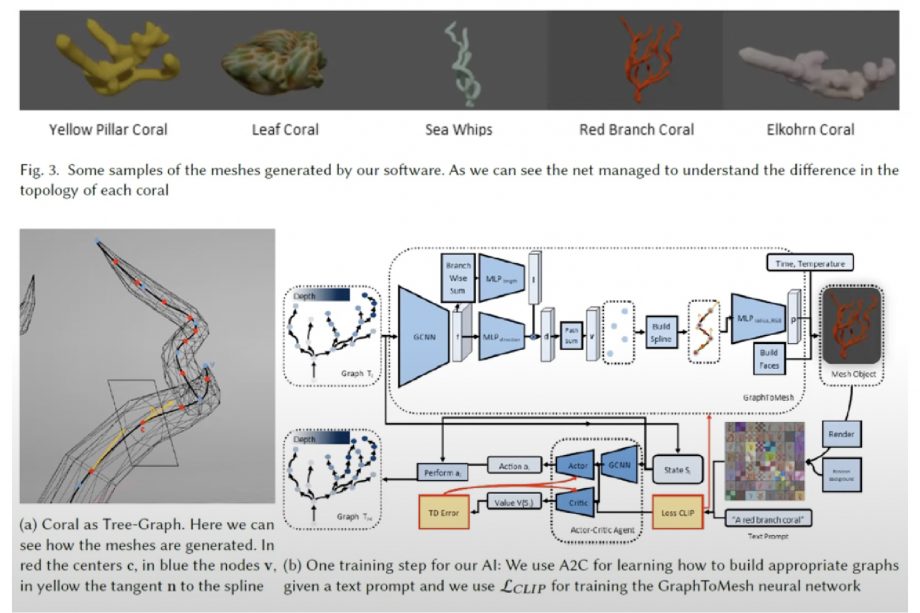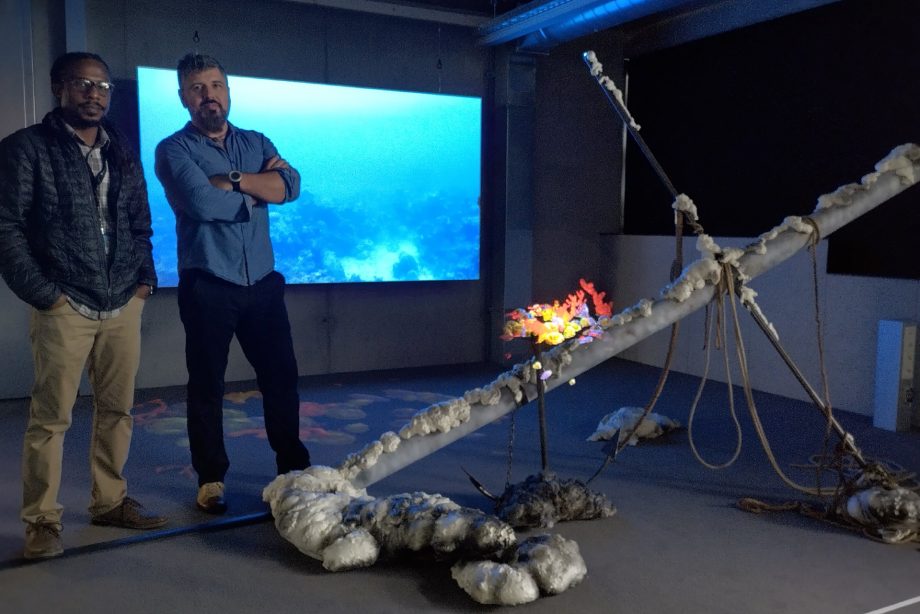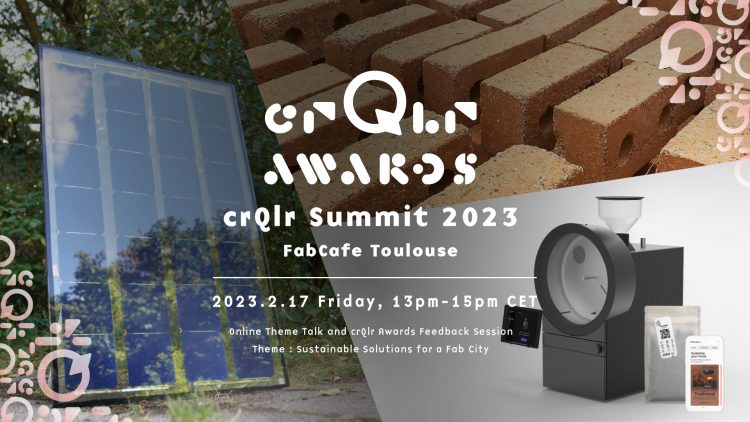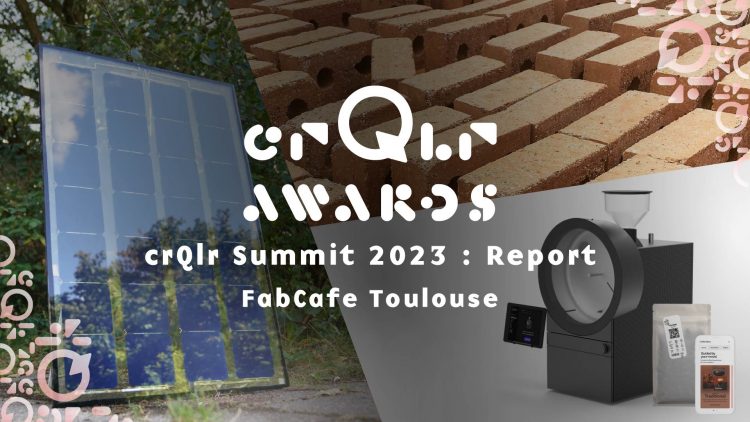Event report
April 12, 2023
David Willoughby
Freelance Writer
Sustainability is often described in measurable impacts, but it’s also about changing minds. That’s where artists have a huge role to play. This edition of the crQlr Summit focused on the potential of art to shape awareness and attitudes towards the circular economy. Three crQlr Award winners, whose methods range from data visualization to collaboration with non-human life, joined the Summit to discuss how artistic practice differs from design-led approaches in its attitudes toward the role of the practitioner and the definition of success.
Following earlier crQlr Summits held in France and Japan, this Summit was hosted by FabCafe Mexico City, whose co-founder Tania Aedo is doing interesting work herself in bioart and lab-based practice. This report will include highlights of a panel discussion between the judges and winners. But first, let’s hear from the winning projects.
Aquaterrestrial Recolonization won the Data Visualization Prize at the crQlr Awards 2022 for its work to preserve the undersea environment. Originating as a project at the University of the Bahamas – which are surrounded by the world’s second-largest coral reefs – the concept uses video, holographic projections and sounds from the ocean floor to recreate what coral reefs are supposed to look like in their unspoilt natural state.
Professor Predrag K. Nikolic of the College For Creative Studies in Detroit is one of four artists working on this project. Predrag joined the Summit to talk about the ecological destruction being waged on coral reefs by climate change, pollution and marine debris. There is hope though. Coral reefs are technically animals, not plants. They source their food instead of making it, and in the right conditions can flourish and return to their former state, even within our lifetimes. For now, the challenge is to keep that possibility alive, and Aquaterrestrial Recolonization works with a partner called AI.R Lab to feed data to the installation for a continuous visualization of this regenerative potential. This also has real-world implications, as Pedrag explains:
Artificial intelligence doesn’t work without a domain of knowledge. Humanity has really poor resources and poor domain knowledge related to our planet, including coral reefs. One of the contributions of the project is collecting that data for future generations. They will definitely need it if they’re in a position to recover the planet with advanced technology – if we were not able to do that during our lifetime.
– Predrag K. Nikolic, Aquaterrestrial Recolonization
Another Moon was awarded the Digital Art Prize for a striking concept that materializes the ephemeral nature of energy in a free-flowing state. It is the work of Kimchi and Chips, a Seoul-based art collective founded in 2009 by Mimi Son and Elliot Woods. Mimi joined this crQlr Summit to talk about the duo’s practice and how they involve natural forces such as wind and solar energy as collaborators in their work.

Mimi begins by introducing Halo, a predecessor project of Another Moon. In Halo, which was exhibited at London’s Somerset House in 2018, the duo used robotic mirror modules to project the Sun’s light into a floating circle. There is an element of randomness to this. While the Sun’s movement’s are predictable, the circle is only visible due to mist, which is subject to wind – an unpredictable force. The entire work had to be designed, in Mimi’s words, “to collaborate with wind, instead of fighting against it.”
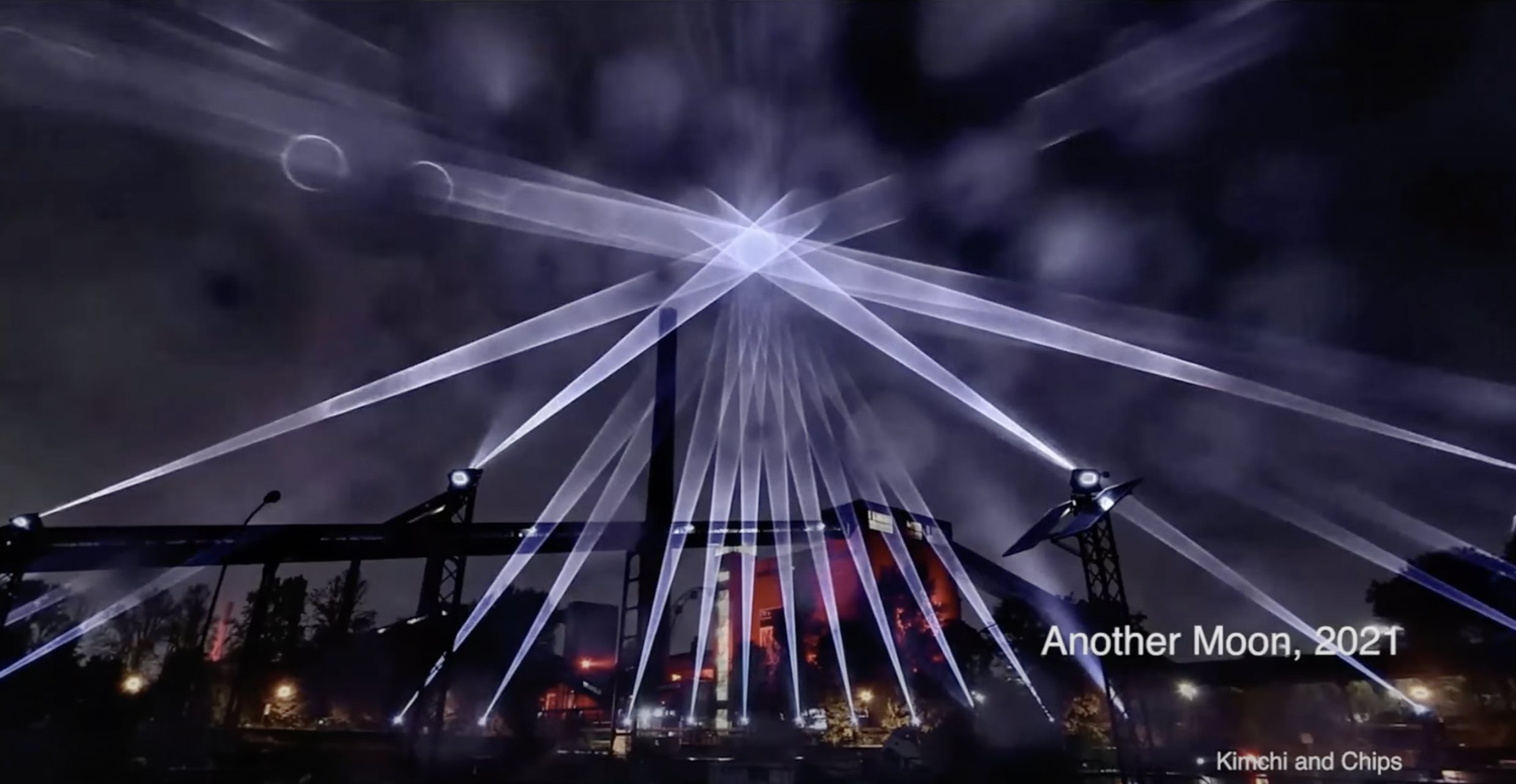
Another Moon builds on this concept by projecting another celestial object using only light from the Sun. First exhibited at a former German coal mine in 2021, it consists of 40 laser modules that collect solar energy from the day, before releasing it at night. While all the lasers are programmed to turn on at the same time, they each turn off individually once their solar batteries run out, so there’s a sense in which the Sun is an active participant in the work. Mimi brings a background in design research and speculative design, and this manifests in her reluctance to ascribe meaning or even intent to these works. Instead, audiences are encouraged to draw their own conclusions:
We really wanted to make a public artwork that everyone can see from where they’re standing. They can approach it quite closely, but we also wanted to put a beautiful distance between the artwork and the audience – so that they can just enjoy it from everywhere and from all different perspectives.
– Mimi Son, Kimchi and Chips
AirBubble, winner of the Bio Design Prize, is the world’s first playground integrating air-purifying micro-algae cultures. It is the work of architectural practice ecoLogic Studio, whose co-founders Claudia Pasquero and Marco Poletto joined the Summit to discuss their vision of how cities can move from a “metabolically linear” model of resources in, waste out to a circular model in which pollution and waste are converted into sustainable resources and architecture.

Marco begins by introducing their Photosynthetica project, which looks for ways to integrate photosynthetic micro-algae into the built environment. These algae are some of the oldest organisms on the planet and already play an outsized role in removing atmospheric carbon. In 2017, ecoLogic Studio piloted the Photosynthetic Curtain, a thin layer that wraps around a building and provides as much carbon capture as a large tree. Polluted urban air rises up through the curtain, reacts with the algae inside, and is transformed into biomass, with oxygen as a byproduct. The curtain takes up no space and requires no maintenance – two of the key barriers to introducing nature-based solutions into the urban environment.
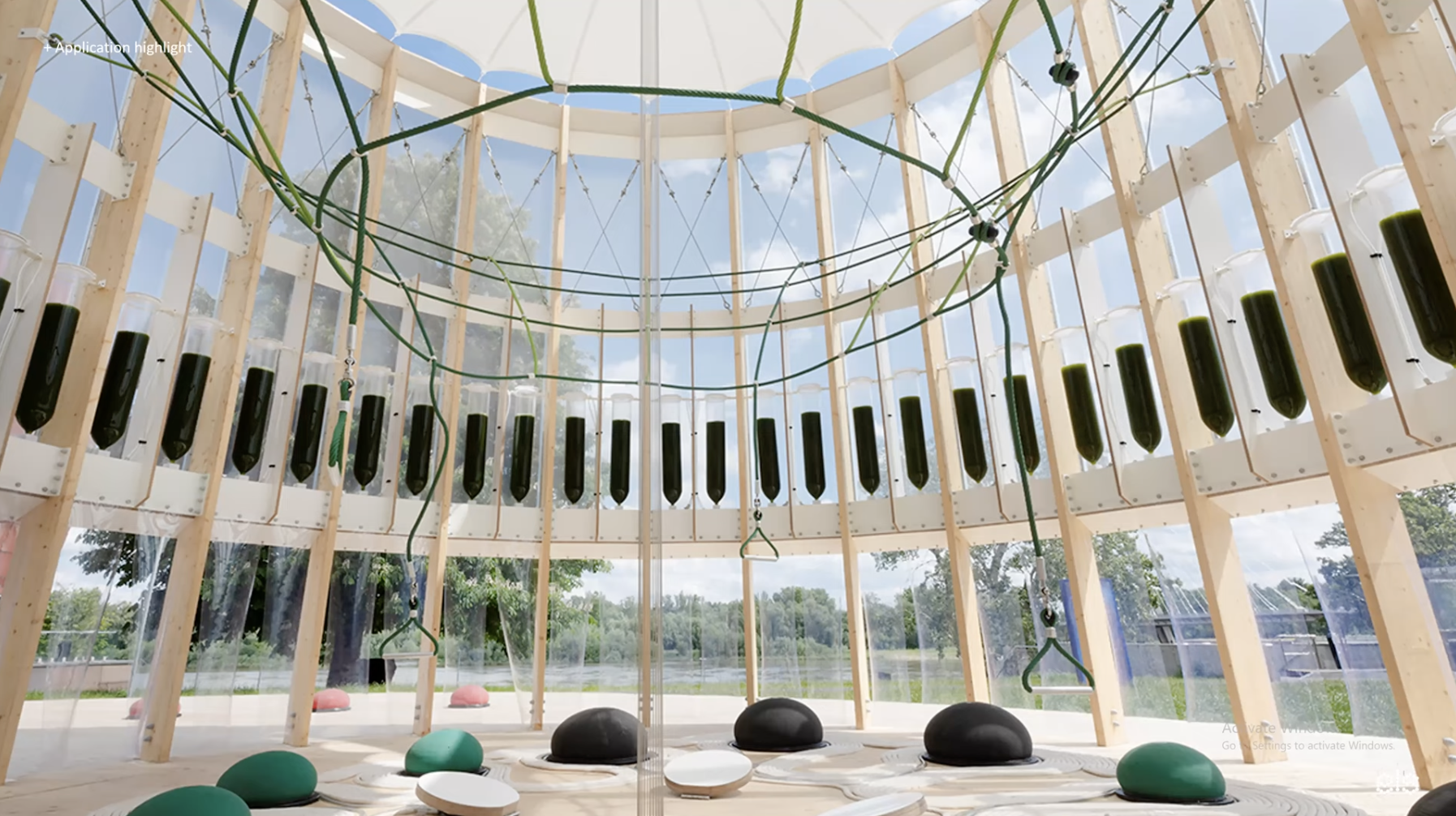
Similar processes can be used to convert pollutants into 3D-printable biopolymers as an alternative to plastics. What’s unique about ecoLogic Studio is their willingness to combine technology with more playful, art-based approaches. This includes AirBubble, the biotechnological playground they built for the heavily polluted city of Warsaw. AirBubble consists of 52 glass algae reactors that fill with air as a result of children’s play, creating a purified microclimate. Thinking at the micro level is a way to tackle problems that seem too big to solve, as Marco explains:
Monitoring stations don’t take into account the microclimatic nature of pollution. Often the concentration of pollutants changes dramatically, especially at the lower level where children run and play. AirBubble was trying to shift that perspective and also bring to the forefront the possibility offered by architecture and nature-based technology to actually begin to solve the problem. Not by purifying the entire atmosphere of the city, because that’s impossible, but by beginning to create pockets or bubbles where the air is substantially cleaner measurably, and offering these as a kind of alternative space.
– Marco Poletto, ecoLogic Studio
Moderator Kelsie Stewart led a panel discussion in which the guest artists talked about some of the issues arising from their practice. Edited highlights follow:
Kelsie: What has been your experience in seeing art raise awareness and provoke an emotional response for a more sustainable future?
Mimi: In our artistic practice, we don’t really think about conveying some message or concept. We try to bring questions rather than answers, which is maybe the biggest difference between art and design. We don’t even hope that people will get a certain feeling from our work – we hope that everyone can have different questions and different emotions.
Marco: When you talk about sustainability, the numerical and measurable element always comes first. That’s partly why there hasn’t been enough progress in society on these issues. We always try to play this double game in which we engage the topic through a numerical or technology-driven approach, only to then present a final artifact that often provokes reactions of a very different nature. The quantitative side and the emotional side need to engage with each other to be able to grasp more profoundly the complexities of our urban realm and the societal response to the climate crisis.
Kelsie: Who are your key outside partners in creating your work and what has working with those partners looked like?
Mimi: Technology is constantly developing, so a really important partner is actually a diligent, predictable practice. This is important not just for learning new technologies, but for understanding new human behavior. All our behavior is structured by technology, social media and capitalism, so we have to be really diligent about being aware of what manipulates us. That’s our big challenge all the time – to understand if something is actually coming from ourselves or if we’re just affected by somebody else.
Marco: As you anticipated with your question, we’re trying to develop new sensibilities through interaction with organisms like algae, but also more and more with algorithms. For example, we’ve done videos with algorithms where the outcome of the video is very much a conversation with the algorithm itself. In a sense, this is not new – because you could argue that even with a pencil you establish a dialogue with your tool. But today there are opportunities for creatives to expand this element of non-human intelligence or non-human perspectives. The space of possible solutions is greatly amplified when you start to look at all the systems that surround us. The classic example we give is how what we consider pollutants are effectively nutrients for microorganisms like algae.
Claudia: The main format that we explore is the slime mold Physarum polycephalum and this is a model that we are trying to apply both in the practice itself – which is our way of operating with the client – but also with many of the organisms we work with.
Kelsie: Yes, if we could just change our lens on the situation, we’d be able to see that solutions have been happening all along and sometimes happening in a dark way. I watched a video in which you both talked about this dark side of ecology, such as leveraging pollution as opposed to seeing it as a problem, and it was really fascinating. We need artists to show us this kind of thing – and express it in a way that people can start to empathize with.
I have one last question: what challenges are you all looking forward to tackling in the future?
Marco: One of the challenges that I’m sure everybody is facing is how to effectively structure a collaborative model of business that’s economically viable while still maintaining this multi-layered ability to operate across disciplines – so that particles of pollution become design elements or AI algorithms are your co-creators. There are also the economic, legal and normative repercussions of pushing these models forward. For example, introducing bacteria in a public space or office environment is directly clashing against a series of accumulated norms at the core of building regulations and our modern obsession with sanitation. When we’re advocating a city that can remetabolize its own pollution, we’re pretty much advocating that somebody is going to end up eating the product of a process converting chemical pollution into food, so there are big challenges there.
Mimi: My personal challenge is not giving up. Making great work is a beautiful challenge, but the most important thing is that I survive. Without myself, I can’t really think about any challenge. Our first challenge is really to survive ourselves – as an artist, teacher, designer or programmer – and not stop working.
Kelsie: Absolutely. Who would have guessed ten years ago that a virus would become one of the greatest stakeholders of our generation? Artists and non-artists alike were given this challenge of not giving up and continuing to work. As Marco mentioned, it’s also about building a better business model so that artists can create more impact – not just with clients but with all different kinds of partners. Thank you so much for that very human point!
About the crQlr Awards

Launched in 2021 by FabCafe Global and Loftwork as Japan’s first award in the field of circular design, the crQlr Awards aim at supporting the future-designers who are working toward the implementation of circular economy systems. Our goal is to nurture a community where players can connect across industries and countries and share knowledge and technologies in order to uncover potential and create new value.
How can we develop impactful circular systems in a wildly diverse world? FabCafe branches across different countries have proven that long lasting change often starts small and responds to the specific needs of local communities. Thus, in its second edition, the crQlr Awards have introduced the FabCafe Global Special Prize, which will highlight bottom-up activities aimed at solving community issues.
-
David Willoughby
Freelance Writer
David thinks and writes about sustainability, technology and culture, and has reported on many of our hackathons, talks and other events. He also works with Japanese companies to help tell their stories to the world.
David thinks and writes about sustainability, technology and culture, and has reported on many of our hackathons, talks and other events. He also works with Japanese companies to help tell their stories to the world.

